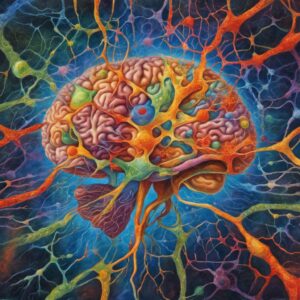The endocannabinoid system (ECS) is a complex cell-signaling system found in humans and other mammals. It plays a crucial role in regulating various physiological processes, including mood, appetite, memory, pain sensation, and immune function. The ECS consists of three main components: endocannabinoids, receptors, and enzymes.
Endocannabinoids are naturally occurring compounds produced by the body. The two primary endocannabinoids identified so far are anandamide (AEA) and 2-arachidonoylglycerol (2-AG). These endocannabinoids are synthesized on-demand and act as retrograde messengers, meaning they are released from postsynaptic neurons and travel backward to bind to cannabinoid receptors on presynaptic neurons.
Cannabinoid receptors are found throughout the body and are classified into two main types: CB1 receptors and CB2 receptors. CB1 receptors are primarily located in the central nervous system, including the brain and spinal cord, while CB2 receptors are mainly found in the peripheral tissues, particularly in immune cells. When endocannabinoids bind to these receptors, they trigger various physiological responses.
Cannabis compounds, such as tetrahydrocannabinol (THC) and cannabidiol (CBD), interact with the endocannabinoid system. THC is the primary psychoactive compound in cannabis and binds to CB1 receptors, leading to the euphoric and psychoactive effects commonly associated with marijuana use. CBD, on the other hand, does not bind directly to cannabinoid receptors but can modulate their activity and interact with other receptors in the body.
The interaction between cannabis compounds and the endocannabinoid system can have various effects on the body. THC’s binding to CB1 receptors in the brain can result in altered perception, mood changes, and increased appetite. CBD, on the other hand, has been found to have potential therapeutic effects, such as reducing inflammation, relieving pain, and alleviating anxiety, without causing the psychoactive effects associated with THC.
It is important to note that the research on the endocannabinoid system and cannabis compounds is still ongoing, and there is much more to learn about their interactions and potential therapeutic applications. However, the existence of the endocannabinoid system and its role in regulating various physiological processes is well-established.
Sources:
1. National Center for Biotechnology Information. (n.d.). The Endocannabinoid System, Cannabinoids, and Pain. Retrieved from https://www.ncbi.nlm.nih.gov/pmc/articles/PMC3820295/
2. National Institute on Drug Abuse. (2020, July 10). Marijuana as Medicine. Retrieved from https://www.drugabuse.gov/publications/drugfacts/marijuana-medicine
3. Russo, E. B. (2008). Cannabinoids in the management of difficult to treat pain. Therapeutics and Clinical Risk Management, 4(1), 245\\u2013259. Retrieved from https://www.ncbi.nlm.nih.gov/pmc/articles/PMC2503660/











